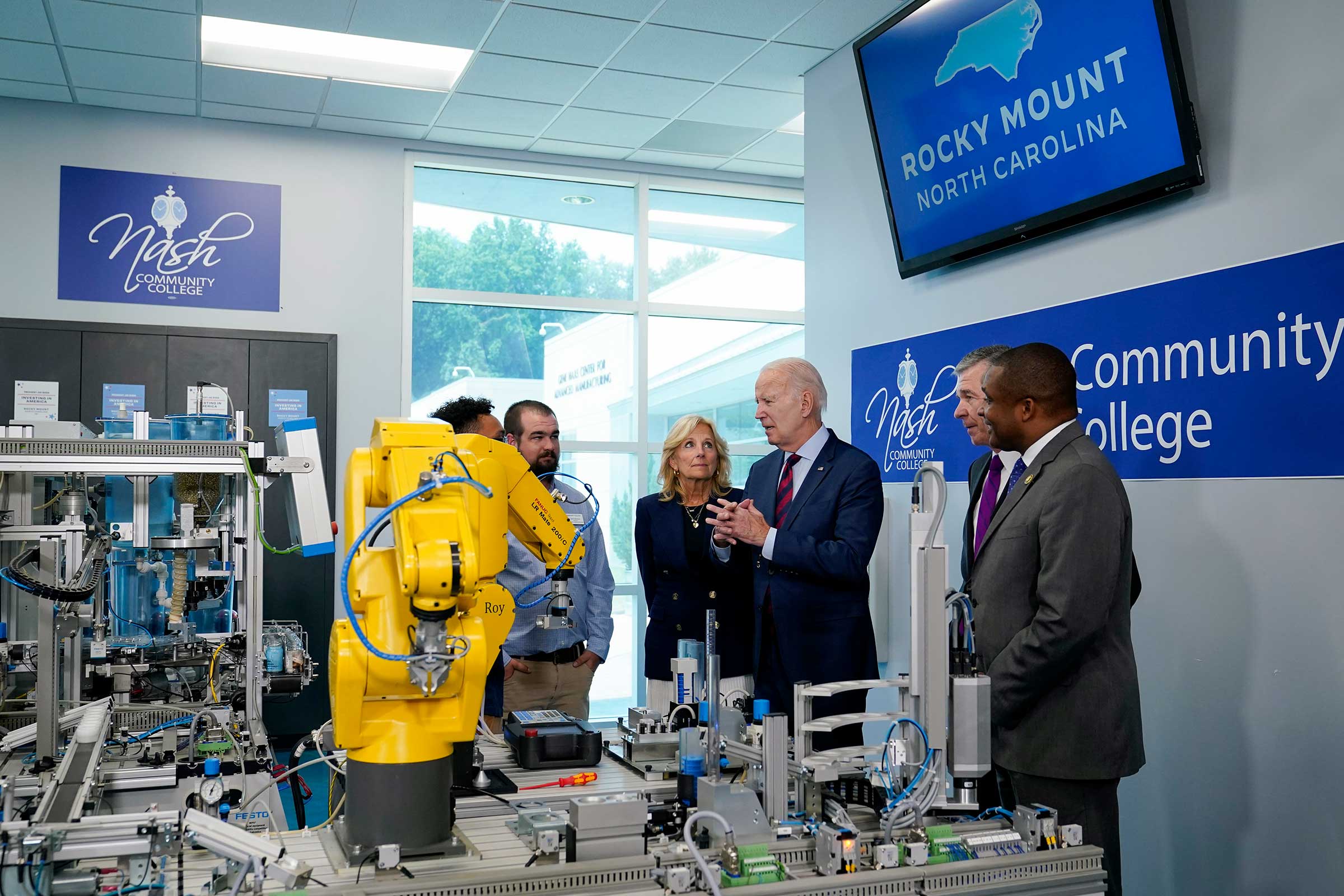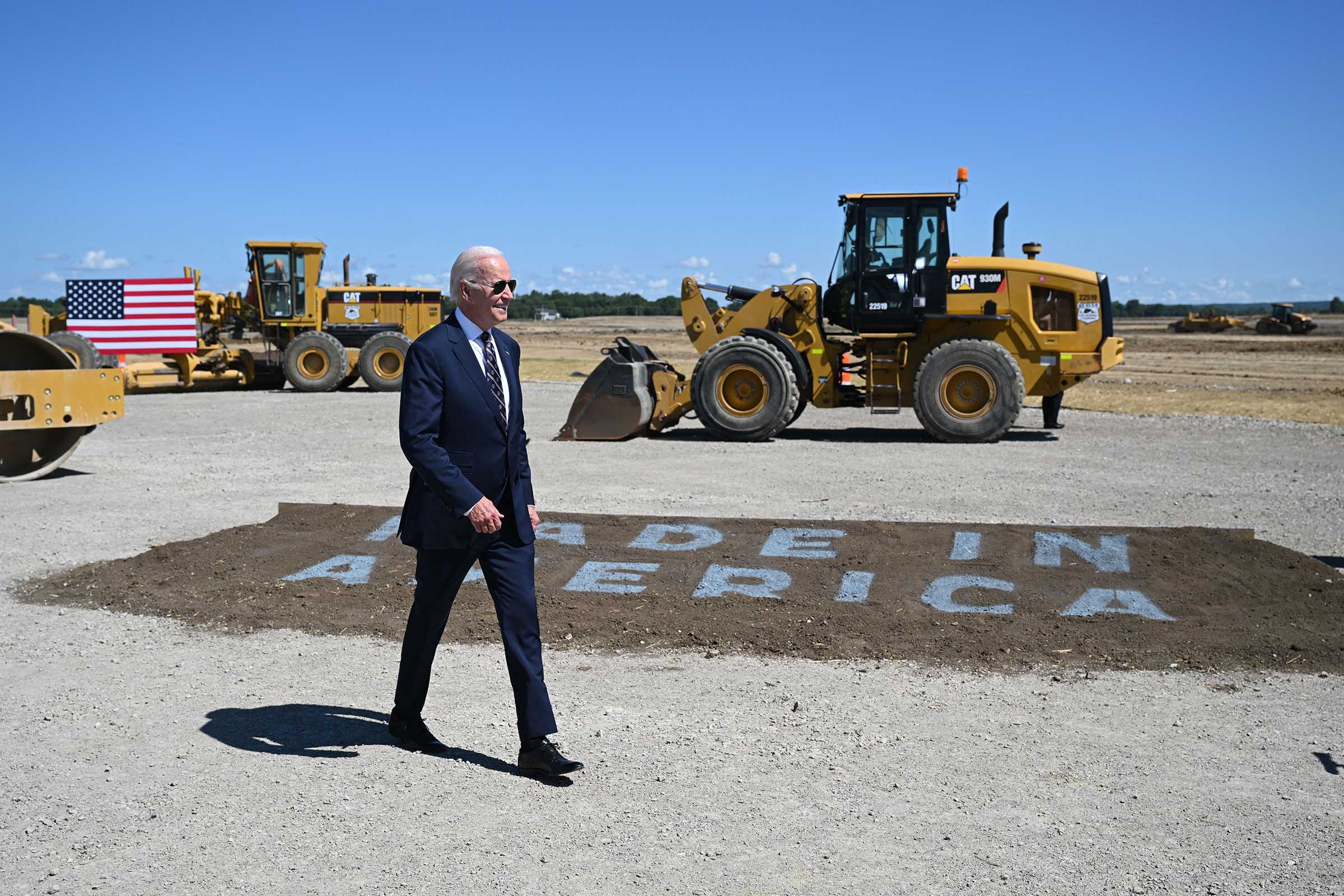On June 9, President Joe Biden and the First Lady made a rare visit to the small town of Rocky Mount, N.C., a diverse enclave in a battleground state that his team believes he can win in 2024. It was the town’s first visit from a sitting president since Lyndon B. Johnson in 1964, drawing hundreds of residents to line the streets and wave as the presidential motorcade made its way through town.
For Biden, the stop in Rocky Mount was aimed at persuading voters that his policies are bringing manufacturing back to the U.S. after decades of offshoring, as well as creating new, well-paying jobs that don’t require a college degree. He was there to visit the Nash County Community College, which holds a new 96-hour course supported by government funds designed to help students pursue a career in manufacturing without a traditional four-year degree. “Look, you can’t have advanced manufacturing without a highly trained workforce. They don’t go together,” Biden told the assembled students. “That’s where you all come in.”
But as the President travels the country to tout his economic vision, industry experts have warned that manufacturers may run into trouble hiring enough workers. According to a report from Deloitte, the U.S. semiconductor industry could face a shortage of about 70,000 to 90,000 workers over the next few years, in part because skilled workers and those with advanced technical degrees are choosing to work at big technology firms instead of manufacturing facilities. McKinsey has also projected a shortage of 90,000 skilled technicians in the U.S. by 2030. The Commerce Department is aware of the looming issue: “We really have to just get a lot more serious about it, and also develop new pipelines,” Secretary Gina Raimondo said at a summit on April 18. “The forecasts are that we’ll be about 100,000 semiconductor technicians short in the next handful of years, if we don’t do something differently. That’s a huge problem.”

When asked if the Administration is worried that there won’t be enough workers to fill all the jobs created by the CHIPS and Science Act, a senior Commerce Department official responded: “Look, it’s a challenge and our job here is to address the challenge.”
Biden may also have misled prospective applicants on salary expectations. In his most recent State of the Union address, he said the CHIPS Act has created jobs that pay an average of $130,000 a year, many of which do not require a college degree. But company representatives from Intel, the company responsible for many of the workforce training programs launched so far, note that the $130,000 figure that Biden officials have touted is an average amount that could be skewed by management and employees with advanced degrees.
“It doesn’t mean that every job is going to pay six figures,” a separate senior Biden Administration official says. “That’s the average. When you aggregate all the jobs—the four-year degree jobs, the two years, the training certificates—you will get a number like $135,000… But of course it’s a mix of jobs.”
Still, having more jobs than workers—and a plan to address the shortfall—isn’t a bad place to be politically, and the Biden Administration is hopeful that it can blunt a possible workforce shortage and bring crucial manufacturing jobs back to the U.S. to compete with China.
Across the country, community colleges, universities, and school districts have been creating or expanding training programs to attract more students to the semiconductor industry, which experts say is on the cusp of a manufacturing boom. To receive a slice of the federal subsidies under the CHIPS Act, the Commerce Department is requiring companies to submit applications that include detailed plans about how they will recruit and retain workers, prompting a new wave of workforce training programs. “Workforce development is a core part of our application and evaluation process,” the senior Commerce Department official says. “It’s really important on a regional and local basis to build the workforce necessary to fill these jobs. Partnerships with university systems, community colleges, workforce and labor organizations—these are all the types of things that we are expecting our applicants to see.”
In Maricopa County, Ariz., outside Phoenix, three community colleges have partnered with Intel to offer a “Quick Start” program aimed at preparing students to become entry-level technicians at Intel, its suppliers, or other semiconductor manufacturers in just 10 days, funded by a grant from the Arizona Commerce Authority and at no cost to the students if they complete the course. Students who graduated from the boot camp told TIME that they were taught the basics of how chips are made, practiced using various hand tools, and tried on the head-to-toe gowns (called “bunny suits”) that technicians wear to prevent stray lint or hair from damaging the wafers. Even a speck of dust can ruin the chip-making process.

Lisa Strothers, a 35-year-old from Phoenix, Ariz., had just been laid off from her job as a loan support specialist when she received an email about the program. “Begin your exciting new career with only 10 days of training,” the message read. It was a path she had never considered, given her non-technical background, but she decided to give it a try. “It was a lot of information in a short period of time, but they tried to make it very basic so you can still understand,” Strothers says. “Only one or two people had some type of technology background in our class; the rest of us did not.” Just a few weeks after completing the 10-day program and passing a certification exam, she applied for a job at Intel and was hired as a process technician, responsible for helping troubleshoot equipment and tools.
Intel says that demand for the Quick Start program is so high that it had to put hundreds of people on a waiting list just to enroll in the program at its two locations in Phoenix and Portland, Ore. In February, Intel launched a similar “rapid” certification program in Ohio, where the company is breaking ground on its planned $20 billion semiconductor facilities set to open in 2025 and employ 3,000 people and require 7,000 construction workers to build. The Ohio program currently has 260 registered students.
“The question of how we scale and how we serve that level of interest is one in our minds right now,” says Gabriela Cruz Thompson, Intel’s director of University Research Collaboration. “Quick Start is still in pilot program mode. We don’t want to over scale and then under serve the students. We want to hear a little bit more from the community in terms of what skills people are getting and make the appropriate adjustments as we might scale this into the future.”
So far, the training program has served more than 600 students in Arizona since it began in July 2022. Patty Mfoloe, a graduate of the Portland program after she was laid off from her job in the healthcare sector, said the 10-day bootcamp was challenging at first, but it allowed her to learn more about the chips that run nearly every piece of technology we use. “It was one of the things that I’ve never done in my life,” says Mfoloe, who now works for Intel as a manufacturing technician in which she’s responsible for the tools that create chips.
The average annual income of program graduates upon job placement is $43,000, according to Fresh Start, a Phoenix-based nonprofit women’s foundation that partnered on the initiative with Intel and Mesa Community College. In Oregon, an advertisement for the workforce training program claimed entry level semiconductor technicians earn between $18 and $24 per hour, which translates to an annual salary range of roughly $37,000 to $50,000.
Intel claims the training program is just a starting point for a career in the semiconductor manufacturing industry that the Biden Administration is hoping will be better equipped to compete with China and Taiwan, which have dominated the chips race for several decades. Semiconductors were invented in the U.S., but many manufacturers moved their facilities overseas in search of cheaper labor costs and incentives from foreign governments, dragging the U.S. share of chip production down to about 12% today from 37% in the 1990s.
To attract chipmakers back to the U.S., Biden signed into law last summer the CHIPS and Science Act, which centers on $52 billion in subsidies for semiconductor manufacturing in the U.S. It has already sparked an outpouring of new private investments in chip plants around the nation, most of which are outside big cities and seek to catalyze economic growth in parts of the country that could use a spark.
The challenge now is getting enough people to fill the jobs at those manufacturing plants. Training workers for free in just 10 days could be the key. “I feel like the program is giving people a foot in the door that otherwise wouldn’t even think about doing it,” Strothers says. “Including myself.”
More Must-Reads from TIME
- Cybersecurity Experts Are Sounding the Alarm on DOGE
- Meet the 2025 Women of the Year
- The Harsh Truth About Disability Inclusion
- Why Do More Young Adults Have Cancer?
- Colman Domingo Leads With Radical Love
- How to Get Better at Doing Things Alone
- Michelle Zauner Stares Down the Darkness
Write to Nik Popli at nik.popli@time.com
